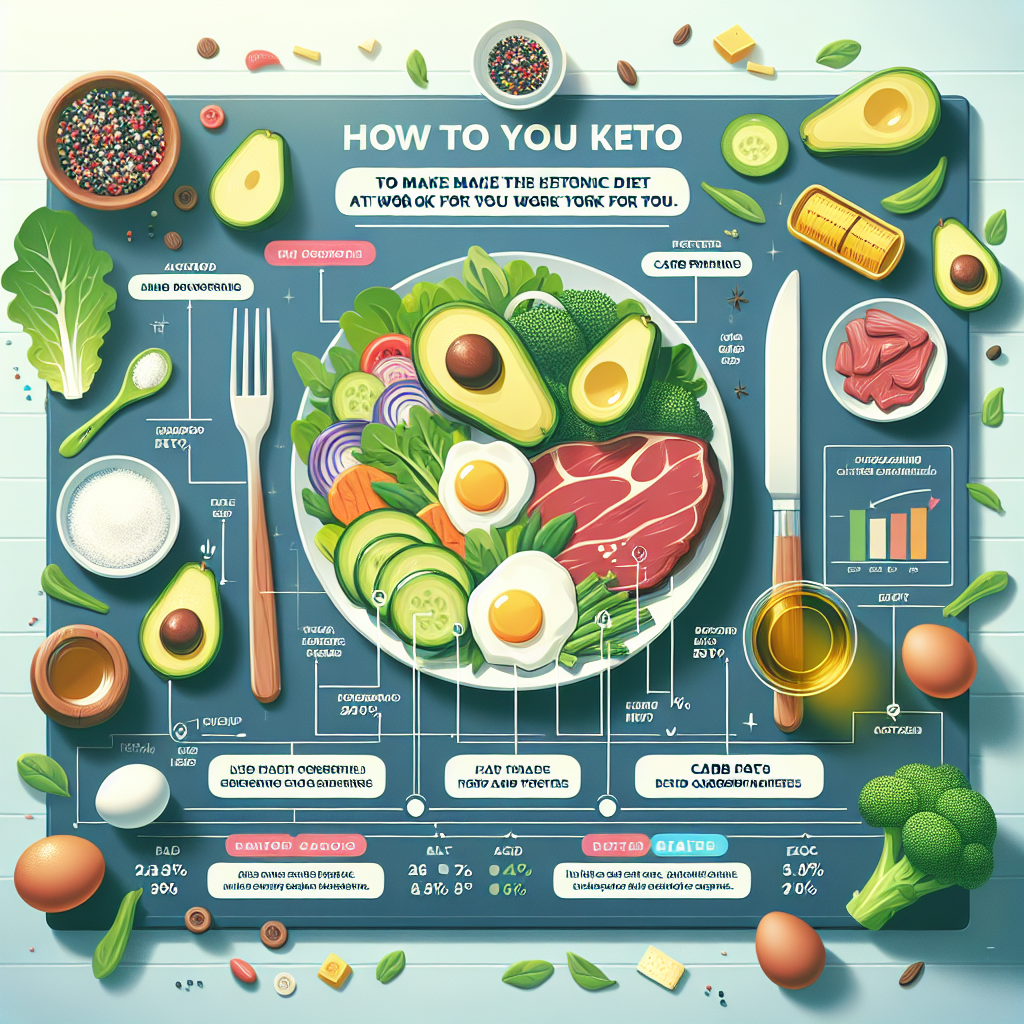How to Make the Ketogenic Diet Work for You

Ready to transform your health with the ketogenic diet? Learn how to make it work for you! Visit My Vibrant Vitality now and start your journey towards a healthier lifestyle.
Maximizing the Benefits of the Ketogenic Diet: A Comprehensive Guide
The ketogenic diet, often referred to as the keto diet, has gained significant popularity in recent years due to its potential benefits for weight loss, diabetes management, and overall health improvement. However, to maximize the benefits of this low-carb, high-fat diet, it’s essential to understand how it works and how to tailor it to your individual needs and lifestyle.
The ketogenic diet primarily works by shifting your body’s metabolism from burning carbohydrates to burning fats for energy, a state known as ketosis. This metabolic state can lead to rapid weight loss, improved blood sugar control, and increased energy levels. However, achieving and maintaining ketosis requires careful planning and commitment.
Firstly, it’s crucial to understand the macronutrient ratio of the ketogenic diet. Typically, it consists of 70-75% fats, 20-25% protein, and only 5-10% carbohydrates. This means that your diet should primarily consist of high-fat foods like avocados, nuts, seeds, and oils, moderate amounts of protein from sources like meat, fish, and eggs, and minimal amounts of carbohydrates from non-starchy vegetables and low-sugar fruits.
However, it’s not just about the macronutrient ratio. The quality of the foods you consume is equally important. Opt for whole, unprocessed foods and avoid processed meats, refined oils, and foods high in added sugars. This not only helps you achieve ketosis but also ensures you’re getting a wide range of nutrients to support overall health.
Next, consider your individual energy needs. The amount of food you need to consume on a ketogenic diet depends on various factors, including your age, sex, weight, activity level, and health goals. For instance, if you’re aiming for weight loss, you’ll need to create a calorie deficit, which means consuming fewer calories than you burn. On the other hand, if you’re looking to maintain your weight or gain muscle, you’ll need to consume enough calories to meet your energy needs.
Monitoring your progress is another key aspect of making the ketogenic diet work for you. Regularly check your ketone levels using a blood ketone meter, urine strips, or a breath analyzer. This can help you determine whether you’re in ketosis and make necessary adjustments to your diet if needed. Additionally, keep track of changes in your weight, body composition, energy levels, and overall health to assess the effectiveness of the diet.
Lastly, remember that the ketogenic diet is not a one-size-fits-all solution. It may not be suitable for everyone, especially those with certain medical conditions like liver disease, pancreatitis, or certain metabolic disorders. Therefore, it’s essential to consult with a healthcare professional or a registered dietitian before starting the diet.
In conclusion, maximizing the benefits of the ketogenic diet involves understanding the diet’s principles, tailoring it to your individual needs, consuming high-quality foods, monitoring your progress, and seeking professional advice when needed. With careful planning and commitment, the ketogenic diet can be a powerful tool for achieving your health goals.
Unlocking Your Health Potential: Steps to Make the Ketogenic Diet Work for You

The ketogenic diet, often referred to as the keto diet, has gained significant popularity in recent years. This low-carb, high-fat diet is lauded for its potential to promote weight loss, improve mental clarity, and even manage certain health conditions. However, like any dietary regimen, the ketogenic diet is not a one-size-fits-all solution. It requires careful planning and execution to ensure it works effectively for you. Here are some steps to help you unlock your health potential and make the ketogenic diet work for you.
Firstly, understanding the science behind the ketogenic diet is crucial. The diet works by shifting your body’s primary fuel source from glucose (derived from carbohydrates) to ketones (derived from fats). This metabolic state, known as ketosis, encourages your body to burn fat more efficiently. However, achieving and maintaining ketosis requires a careful balance of macronutrients—typically around 70-75% fat, 20-25% protein, and 5-10% carbohydrates.
Next, it’s essential to plan your meals meticulously. The ketogenic diet is not just about cutting carbs; it’s about replacing them with healthy fats and adequate proteins. Incorporate foods like avocados, nuts, seeds, fatty fish, and lean meats into your diet. Avoid processed foods and those high in sugar. Remember, the goal is to consume nutrient-dense, whole foods that will provide your body with the energy it needs while keeping you in ketosis.
Monitoring your progress is another vital step. Regularly check your ketone levels using a blood ketone meter, urine strips, or a breath analyzer. These tools can help you determine whether you’re in ketosis and how dietary changes are affecting your progress. Additionally, keep track of your energy levels, mental clarity, and overall well-being. These subjective measures can provide valuable insights into how well the diet is working for you.
While the ketogenic diet can offer numerous health benefits, it’s important to remember that it may not be suitable for everyone. Certain individuals, such as those with type 1 diabetes, pregnant or breastfeeding women, and those with certain metabolic disorders, should avoid the diet or approach it with caution under medical supervision. Always consult with a healthcare professional before starting any new diet regimen.
Moreover, it’s crucial to be patient and consistent. Transitioning to a ketogenic diet can be challenging, especially during the initial stages when you may experience symptoms of the “keto flu,” such as fatigue, headaches, and irritability. These symptoms are temporary and typically subside as your body adjusts to burning fat for fuel. Stick with the diet, and over time, you’ll likely start to see and feel the benefits.
Lastly, remember that a healthy lifestyle is about more than just diet. Regular physical activity, adequate sleep, and stress management are all essential components of overall health and well-being. Incorporating these practices along with the ketogenic diet can help you achieve and maintain optimal health.
In conclusion, the ketogenic diet holds great potential for those looking to improve their health and well-being. By understanding the science behind it, planning your meals carefully, monitoring your progress, consulting with a healthcare professional, being patient and consistent, and adopting a holistic approach to health, you can make the ketogenic diet work for you. Remember, the journey to health is a marathon, not a sprint. Take it one step at a time, and you’ll be well on your way to unlocking your health potential.
The Art of Keto: Practical Tips for Making the Ketogenic Diet a Success
The ketogenic diet, often referred to as the keto diet, has gained significant popularity in recent years. This low-carb, high-fat diet is lauded for its potential benefits, including weight loss, improved cognitive function, and even disease prevention. However, like any diet, the key to reaping these benefits lies in your ability to adhere to it consistently. Here, we delve into the art of keto, offering practical tips to make the ketogenic diet a success for you.
Firstly, understanding the basics of the ketogenic diet is crucial. The diet involves drastically reducing carbohydrate intake and replacing it with fat. This reduction in carbs puts your body into a metabolic state called ketosis, where fat, from your diet and from your body, is burned for energy. It’s important to note that the ketogenic diet is not just about cutting carbs, but also about increasing your intake of high-quality fats from sources like avocados, nuts, seeds, and olive oil.
One of the most effective ways to ensure success on the ketogenic diet is to plan your meals. Meal planning helps you avoid the temptation of carb-heavy foods and ensures you have keto-friendly options readily available. This can be as simple as making a list of keto-approved foods to keep on hand, or as detailed as prepping meals for the week.
Another practical tip is to monitor your macronutrient intake. The typical macronutrient ratio on a ketogenic diet is around 70% fats, 25% protein, and 5% carbohydrates. However, these ratios can vary based on individual needs and goals. Using a food tracking app can be a helpful tool to ensure you’re hitting your macronutrient targets and staying in ketosis.
Hydration is another key aspect of the ketogenic diet. As your body enters ketosis, it may shed excess water, which can lead to dehydration if not properly managed. Therefore, it’s essential to drink plenty of water throughout the day. Additionally, as your body adjusts to the diet, you may experience what’s known as the “keto flu,” which includes symptoms like fatigue, headache, and irritability. Staying hydrated and replenishing electrolytes can help alleviate these symptoms.
While the ketogenic diet is primarily focused on food intake, physical activity should not be overlooked. Regular exercise can enhance the benefits of the ketogenic diet by helping to deplete glycogen stores, making it easier for your body to enter ketosis. Whether it’s a brisk walk, a yoga class, or a high-intensity interval training session, incorporating physical activity into your routine can support your ketogenic journey.
Lastly, patience is paramount when embarking on the ketogenic diet. It can take several days to a few weeks for your body to adapt to burning fat for fuel instead of carbohydrates. During this transition period, you may not see immediate weight loss or feel the cognitive benefits. However, with consistency and patience, these benefits will come.
In conclusion, the ketogenic diet can be a powerful tool for achieving various health goals. However, it requires a thoughtful approach and commitment. By understanding the basics of the diet, planning meals, monitoring macronutrient intake, staying hydrated, incorporating physical activity, and practicing patience, you can make the ketogenic diet work for you. Remember, every individual is unique, and what works for one person may not work for another. Therefore, it’s important to listen to your body and adjust your approach as needed. With these practical tips, you’re well on your way to mastering the art of keto.